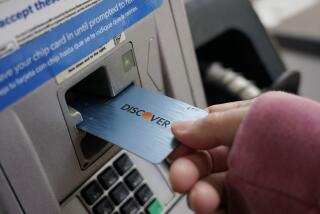Consumer Debt Rises at Weak Pace
WASHINGTON — Borrowing by U.S. consumers increased at a slower-than-expected pace in May as credit card use registered one of the largest declines in nearly two decades, Federal Reserve Board figures showed Tuesday.
Consumer installment debt rose by just $400 million for the month to $1.25 trillion, after rising a revised $5.6 billion during April. Previously, the Fed said April borrowing increased $5.5 billion.
The scant rise in overall May debt was contrary to expectations for a much larger $4.2-billion increase and stemmed entirely from less use of credit cards.
Revolving or credit card debts contracted by $3.3 billion in May, a 7.4% annualized rate of decline.
The Fed said the May drop in credit card debt was the biggest since a 13.2% rate of decrease in June 1980.
Aside from revolving credit, though, other categories of credit kept growing in May at rates roughly equal to April, implying that consumer demand remained buoyant amid a robust economy.
Auto credit expanded by $1 billion. Other types of installment loans rose by $2.6 billion.
Economists watch the Fed’s consumer credit data to help gauge changes in consumer spending, which accounts for two-thirds of overall U.S. economic activity.
While the overall growth rate of installment debt has slowed in recent years, concerns about credit use persist. The Consumer Federation of America on Wednesday accused major banks of aggressively expanding credit card marketing while simultaneously lobbying Congress to rewrite bankruptcy laws that benefit delinquent consumers.
Credit card debt usually isn’t secured by any collateral, and in the bankruptcy process creditors of unsecured loans have their claims paid after secured creditors.
“Banks are hypocritical to seek bankruptcy restrictions when their irresponsible marketing and extension of credit card debt has been an important cause of rising personal bankruptcies,” said Stephen Brobeck, CFA executive director.
Those findings were challenged by MasterCard International, the issuer of 600 million charge cards. “We’ve been hearing that the sky is falling under the weight of consumer debt for years,” said Lawrence Chimerine, a consulting economist for MasterCard. “All economic trends continue to support the ability of American consumers to manage their credit card spending and debt appropriately.”
For the average household, short-term debt represents about 20% of income, according to Standard & Poor’s DRI.
More to Read
Inside the business of entertainment
The Wide Shot brings you news, analysis and insights on everything from streaming wars to production — and what it all means for the future.
You may occasionally receive promotional content from the Los Angeles Times.










